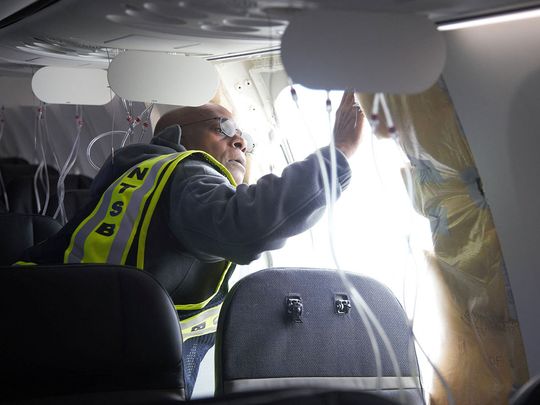The National Transportation Safety Board (NTSB) found a plug that flew out of an unused exit door on an Alaska Airlines flight on Friday. The discovery is believed to be crucial to the investigation into the incident that led the Boeing 737 Max 9 to return to Portland, Oregon shortly after takeoff.
The Federal Aviation Administration (FAA) has grounded all Boeing 737 Max 9s involved in the incident until their safety is assured, an FAA spokesman said Sunday.
Read More: Xreal Targets Apple Vision Pro with Its Latest Augmented Reality Glasses
During a press conference Sunday evening, NTSB Chair Jennifer Homendy expressed gratitude for finding the plug, located near Portland in the backyard of a teacher identified as Bob. She previously referred to this part as a “key missing piece” essential to understanding the cause of the accident.

Homendy told reporters that pilots reported three pressurization warnings on the same plane between Dec. 7 and Jan. 4, with at least one occurring in flight. Despite regular inspections and inspections of the dashboard lights in the cockpit by Alaska Airlines maintenance crews, the incident occurred on Flight 1282, just weeks after the plane was delivered in late October.
Homendy described the chaotic scene in the cockpit and outside after the explosion. The depressurization caused the cockpit door to fly open, prompting the flight crew to don masks. Communication problems persisted both in the flight deck and between cabin and cockpit crew members.
The force of the depressurization damaged the lavatory door as the cockpit door slammed into it, requiring the flight attendant’s efforts to close it again. The captain and first officer were hard of hearing due to damaged headsets and resorted to an overhead speaker to communicate.
During the chaos, a quick reference checklist and various items were tossed around the cockpit. The flight data recorder and cockpit voice recorder were sent to NTSB laboratories for analysis on Sunday. However, the voice recorder may not provide significant insight into the investigation because the NTSB is advocating for an increased recording requirement of 25 hours, a proposal that the FAA currently limits to newly manufactured aircraft.
The FAA’s emergency airworthiness directive affected approximately 171 Boeing 737 Max 9s worldwide, grounding them due to safety concerns, as such directives are issued in response to imminent security threats.

